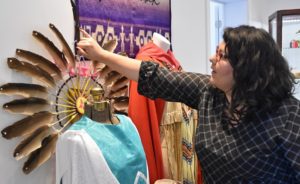Trained at the Canadian Museum of History to guard artifacts at The Dokis Museum

By Kelly Anne Smith
DOKIS FIRST NATION—Adrienne Dokis started out volunteering at her local museum when it opened three years ago. Now she is the manager for The Dokis Museum and has been trained and mentored by experts at the Canadian Museum of History.
Dokis was chosen from across Canada along with three other people to be part of the Aboriginal Training Program. It is designed to offer technical training in museum practices to people of First Nations, Métis and Inuit communities to bring back knowledge and archiving skills to their community.
Excited with the opportunity to learn to care for her community’s artifacts, Adrienne, her partner and their son set out for Gatineau for the eight-month adventure. Dokis spent four weeks researching Ojibway ceremonies and medicines. She was also given the opportunity to create a collection in the First Peoples Hall. Dokis carefully arranged eight pieces of bitten bark work in a mythology section case.
There is a photo of Dokis as one of four participants of the Aboriginal Training Program framed on the wall at The Dokis Museum. One student of the program drove 7,000 kilometres from Inuvik to Gatineau with her son to take part.
Walking into the museum, your eyes are drawn upward. There are two traditional canoes overhead. Dokis begins the guided tour. Circa 1974 and 1975, the canoes lay in the specially designed openings.

“Leonard Dokis made it with an instructor, building the first one. There used to be a camp in Monetville for Aboriginal survival skills, so they taught four boys how to build a canoe on their own. They built it in three days and put it on the water on the fourth day. We just got them back.”
One canoe was retrieved from Henvey Inlet First Nation museum. The museum plans to acquire another canoe to add to the collection.
A newly formed museum committee supervised the operation while Dokis was in Gatineau in the Aboriginal Training Program. They added more items while Dokis was away.
As we enter the craft room and look into a glass display, Dokis points to elaborate beaded works.
“These three are hair ties. This was a barrette. One of the ladies from the museum committee is Marie Dokis and those were her daughters.”
The museum committee also include Veronica Dokis, and Denise Restoule – the former Chief of Dokis. Marie, Veronica and Denise offered their own crafts and historical possessions to start the museum’s collection.
“Those mitts were made by Veronica Dokis. She is also my grandmother,” noted Dokis. “After the museum was built, word started getting out and people from the reserve started bringing things in. Even people off reserve who have family here are bringing things in.”
Standing in front of a woven cradle basket, Dokis says Denise Restoule was passionate about getting the museum built while she was Chief.
“That one with the baby in it was Denise Restoule’s. The cradleboard was Veronica’s.”
In another area, paintings are displayed.
“The portraits are by Fred Restoule. The youth paintings are by Alex Dokis and Lucy Dokis.”
A room is devoted to Gordon Restoule, the traditional environmental knowledge keeper.
“Gord knew what the seasons were going to be just by watching the animals and how they were acting.”
Gord and his wife Jackie were known for their hospitality as owners of Wajashk Cottages.
“This is everything from their wedding day. That’s her dress.”
Moving on to the military display, there are many portraits of veterans.
“This stretcher from World War II is a new addition. And this sword was found last summer. One of the members was marking off his plot of land. His dad tripped on the end of this. So they dug it up and it was a sword.”
A patron knowledgeable about swords thinks it to be dated to about 1850 and of either the British or French cavalry.
A large photo close by shows Germaine Dokis as a “Rosies of the North.” Dokis First Nation member Nellie Knight was also a “Rosies of the North.” Dokis explains women worked on parts of the Hawker Hurricane in Fort William during World War II.
A circular rock in a showcase has caught my eye as Adrienne talks of the significance of its Anishinaabemowin name.
“This one here is what Dokis’s name is. Okikendawt means Land of the pots or kettles. A rock will enter as the currents are flowing and turn a rock spherical by spinning it. It digs into the rock and you get this perfectly circular hole and then the rocks come out shaven down.”
While working at the Canadian Museum of History, Dokis learned that bringing wood from outside into the museum is risky for artifacts.
“At the History Museum they have this thing called ‘the bubble’. It’s really big so the gallery and other museums will bring their articles to put in this bubble to get rid of bugs that might be damaging the items,” says Dokis. “This bustle is pretty old. It was made by Tim Restoule. It was given to my cousin Alex and when I had my son, he gave it to me. If you can see, some of the feathers are broken. If it went all the way to the spine, it could be bugs.”
Dokis advises to place items suspected of infestation into the freezer for at least seven days.
Dokis’ focus now is on properly categorizing all of The Dokis Museum items into a new database. She is looking to expand the Regalia section to exhibit the many types of dancers and is working on creating interactive displays and virtual tours to offer visitors the experience of lived history at The Dokis Museum. She herself looks forward to June when schoolchildren and tour groups visit daily.
“I really enjoy it here. I’ve always wanted to do something with my culture to bring it back to Dokis.”


